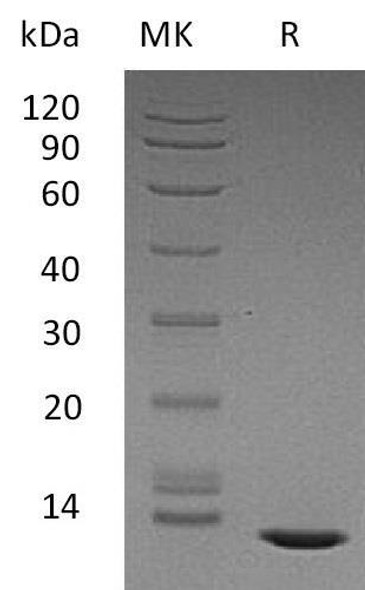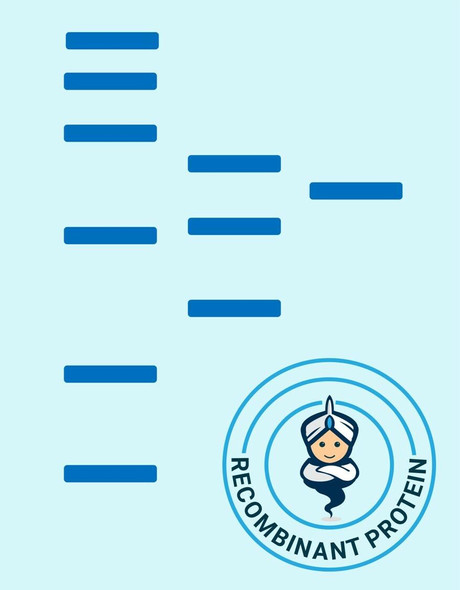Growth Factors & Cytokines Recombinant Proteins
Human TGFB2 Recombinant Protein (RPPB0974)
- SKU:
- RPPB0974
- Product Type:
- Recombinant Protein
- Species:
- Human
- Uniprot:
- P61812
- Research Area:
- Growth Factors & Cytokines
Description
| Product Name: | Human TGFB2 Recombinant Protein |
| Product Code: | RPPB0974 |
| Size: | 5µg |
| Species: | Human |
| Target: | TGFB2 |
| Synonyms: | Transforming growth factor, beta 2, cetermin, Glioblastoma-derived T-cell suppressor factor, polyergin, G-TSF, TGF-beta2, TGF-beta-2, transforming growth factor beta-2, BSC-1 cell growth inhibitor, TGFB-2. |
| Source: | HEK293 Cells |
| Physical Appearance: | Sterile Filtered White lyophilized (freeze-dried) powder. |
| Formulation: | TGF-b 2 was lyophilized from a 0.2�m filtered solution containing 50mM sodium acetate pH 4.5. |
| Solubility: | It is recommended to reconstitute the lyophilized TGF-b 2 in sterile solution containing 20% ethanol, 50mM sodium acetate and 75mM acetic acid. |
| Stability: | Lyophilized TGF-b 2 although stable at room temperature for 3 weeks, should be stored desiccated below -18°C. Upon reconstitution TGF-b 2 should be stored at 4°C between 2-7 days and for future use below -18°C.For long term storage it is recommended to add a carrier protein (0.1% HSA or BSA).Please prevent freeze-thaw cycles. |
| Purity: | Greater than 95% as obsereved by SDS-PAGE. |
| Biological Activity: | The specific activity was determined by the dose-dependent inhibition of IL-4 induced proliferation of mouse HT-2 cells (BALB/c spleen activated by sheep erythrocytes in the presence of IL-2), the ED50 is 0.16ng/ml. |
TGFB2 is a 27.08 kDa protein having two identical 118 amino acid peptide chains linked by a single disulfide bond. TGFB2 is part of a family of five related cytokines that have an extensive variation of normal and neoplastic cells, indicating the importance of these homo-dimmer proteins as multi-functional regulators of cellular activity. The three mammalian isoforms of TGF-beta (TGFb1, TGFb2 and TGFb3) signal through the same receptor and stimulate similar biological responses. They are involved in physiological processes as embryogenesis, tissue remodelling and wound healing.
TGF-b 2 Human Recombinant produced in HEK cells is a non-glycosylated homodimer, having a total molecular weight of 25kDa.The TGF-b 2 is purified by proprietary chromatographic techniques.
| UniProt Protein Function: | TGFB2: TGF-beta 2 has suppressive effects on interleukin-2 dependent T-cell growth. Homodimer; disulfide-linked. Heterodimers with TGFB1 and with TGFB3 have been found in bone. Interacts with the serine proteases, HTRA1 and HTRA3. Interacts with ASPN. Belongs to the TGF-beta family. 2 isoforms of the human protein are produced by alternative splicing. |
| UniProt Protein Details: | Protein type:Cell development/differentiation; Motility/polarity/chemotaxis; Secreted, signal peptide; Secreted Chromosomal Location of Human Ortholog: 1q41 Cellular Component: extracellular matrix; extracellular space; cell soma; axon; extracellular region; endosome Molecular Function:protein binding; protein homodimerization activity; growth factor activity; protein heterodimerization activity; beta-amyloid binding; punt binding; cytokine activity; transforming growth factor beta receptor binding; receptor signaling protein serine/threonine kinase activity; receptor binding Biological Process: heart morphogenesis; extracellular matrix organization and biogenesis; collagen fibril organization; catagen; heart development; dopamine biosynthetic process; SMAD protein nuclear translocation; protein amino acid phosphorylation; cell-cell signaling; hair follicle development; transforming growth factor beta receptor signaling pathway; somatic stem cell division; cell cycle arrest; cell growth; embryonic gut development; cartilage condensation; response to drug; platelet activation; neutrophil chemotaxis; negative regulation of immune response; neuron fate commitment; positive regulation of cell cycle; positive regulation of catagen; positive regulation of cell growth; positive regulation of phosphoinositide 3-kinase cascade; cardioblast differentiation; positive regulation of protein secretion; positive regulation of cell division; activation of protein kinase activity; neuron development; response to progesterone stimulus; positive regulation of heart contraction; cell death; axon guidance; positive regulation of immune response; wound healing; cell morphogenesis; cardiac muscle cell proliferation; positive regulation of stress-activated MAPK cascade; odontogenesis; negative regulation of cell proliferation; platelet degranulation; positive regulation of neuron apoptosis; salivary gland morphogenesis; positive regulation of cell proliferation; response to wounding; hemopoiesis; angiogenesis; positive regulation of integrin biosynthetic process; negative regulation of epithelial cell proliferation; uterine wall breakdown; intercellular junction assembly and maintenance; cell migration; regulation of transforming growth factor-beta2 production; hair follicle morphogenesis; positive regulation of cell adhesion mediated by integrin; glial cell migration; positive regulation of ossification; cell proliferation; embryonic development; eye development; generation of neurons; positive regulation of cardioblast differentiation; response to hypoxia; epithelial to mesenchymal transition; blood vessel remodeling; negative regulation of cell growth; blood coagulation Disease: Loeys-dietz Syndrome 4 |
| NCBI Summary: | This gene encodes a member of the transforming growth factor beta (TGFB) family of cytokines, which are multifunctional peptides that regulate proliferation, differentiation, adhesion, migration, and other functions in many cell types by transducing their signal through combinations of transmembrane type I and type II receptors (TGFBR1 and TGFBR2) and their downstream effectors, the SMAD proteins. Disruption of the TGFB/SMAD pathway has been implicated in a variety of human cancers. The encoded protein is secreted and has suppressive effects of interleukin-2 dependent T-cell growth. Translocation t(1;7)(q41;p21) between this gene and HDAC9 is associated with Peters' anomaly, a congenital defect of the anterior chamber of the eye. The knockout mice lacking this gene show perinatal mortality and a wide range of developmental, including cardiac, defects. Alternatively spliced transcript variants encoding different isoforms have been identified. [provided by RefSeq, Sep 2010] |
| UniProt Code: | P61812 |
| NCBI GenInfo Identifier: | 48429157 |
| NCBI Gene ID: | 7042 |
| NCBI Accession: | P61812.1 |
| UniProt Secondary Accession: | P61812,P08112, Q15579, Q15581, Q4VAV9, B4DKC5, |
| UniProt Related Accession: | P61812 |
| Molecular Weight: | Calculated MW: 47kDa/50kDaObserved MW: 55kDa |
| NCBI Full Name: | Transforming growth factor beta-2 |
| NCBI Synonym Full Names: | transforming growth factor, beta 2 |
| NCBI Official Symbol: | TGFB2�� |
| NCBI Official Synonym Symbols: | LDS4; TGF-beta2�� |
| NCBI Protein Information: | transforming growth factor beta-2; G-TSF; cetermin; polyergin; BSC-1 cell growth inhibitor; prepro-transforming growth factor beta-2; glioblastoma-derived T-cell suppressor factor |
| UniProt Protein Name: | Transforming growth factor beta-2 |
| UniProt Synonym Protein Names: | BSC-1 cell growth inhibitor; Cetermin; Glioblastoma-derived T-cell suppressor factor; G-TSF; PolyerginLatency-associated peptide; LAP |
| Protein Family: | Transforming growth factor |
| UniProt Gene Name: | TGFB2�� |
| UniProt Entry Name: | TGFB2_HUMAN |






